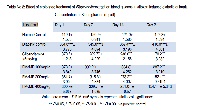The anti-diabetic potentials of methanolic extract of Ficus mollis leaves in alloxan induced diabetic rats
Keywords:
Anti diabetic, Ficus mollis, Alloxan, Blood glucose level, InsulinAbstract
Objective: The present study was designed to evaluate the acute and chronic effects of the extract against alloxan induced diabetic rats. Methods: In acute study, hypoglycemic potency of methanolic extract of Ficus mollis was assessed by oral glucose tolerance test (OGTT) and in chronic study of 21 days, extract at different doses ( ie 100, 200 and 400mg/kg) was screened for its anti-diabetic activity. Blood glucose level had been estimated at 1st, 7th, 14th and 21st and addition to this serum concentrations of insulin, triglycerides, cholesterol, SGOT, SGPT and urea determined at 21st day of the study. Results: In OGTT, standard glibenclamide and extract (200 and 400mg/kg) have shown significant reduction in blood glucose level compared to control group. In chronic model the methanolic extract was more effective in reducing the blood glucose levels (P<0.001) and effect was comparable to that of standard. The extract could also significantly (P<0.001) reduce concentrations of SGOT, triglycerides, cholesterol and urea in serum and significantly (P<0.001) increased the insulin level in blood which proves beneficial effects of the extract in diabetes. The change in concentrations of SGPT and urea were less significant (P>0.01). Conclusion: The methanolic extract of Ficus mollis posses significant antidiabetic activity in alloxan induced diabetic animal model.
References
. Nyemb N, Njifutie N, El Hassane A, et al. Hypoglycaemic and antihyperglycaemic activity of aeratum conyzoides l. in rats. Afr. J. Trad. CAM., 2009, 6 (2): 123 – 130.
. Pandikumar P, Prakash BN, Ignacimuthu. Hypoglycemic and antihyperglycemic effect of Begonia malabarica Lam. in normal and streptozotocin induced diabetic rats. J Ethnopharmacol, 2009, 124:111–115.
. Abha S, Naval KV. Role of Selected Indian Plants in Management of Type 2 Diabetes: A Review. The J Alt. and Compl. Medi, 2004, 10(2): 369-378.
. Vladimir B, Subbalakshmi P, Muhammed MV: A Review of its Potential Role in the Fight Against Diabetes. J Alt. & Compl. Med., 2007, 5(3): 273-291.
. Pharmacology and Pharmacotheraputics. Satoskar RS, Bhandarkar SD, Ainapure SS. Popular Prakashan: Mumbai, 1999. 874.
. Changkeun K. Brown algae Ecklonia cava attenuates type 1 diabetes by activating AMPK and Akt signaling pathways. Food and Chem. Toxicol., 2010, 48: 509–516.
. Sandesh S, Shruti S, Sung-Yum SB. Antidiabetic and antiacetylcholinesterase effects of ethyl acetate fraction of Chaenomeles sinensis (Thouin) Koehne fruits in streptozotocin-induced diabetic rats. Exp. & Toxic. Pathol., 2013, 65:55-60.
. El Sayed SAH. Total phenolic contents and free radical scavenging activity of certain Egyptian Ficus species leaf samples. Food Chemistry, 2009, 114 : 1271–1277.
. Sergio R, Peraza Sanchez. Constituents of leaves and twigs of Ficus hispida. Plant medica 2002, 68:186-8.
. Subhash C, Mandal CK, Ashok Kumar. Studies on anti-diarrhoeal activity of Ficus hispida. leaf extract in rats. Fitoterapia, 2002, 73: 663–7.
. Shanmugarajan TS, Arunsunda M. Cardio protective effect of Ficus hispida Linn on cyclophosphamide provoked oxidative myocardial injury in a rat model. Int. J Pharmacol 2008, 1: 1-10.
. Ghosh R, Sharatchandra KH, Rita S, Thokchom IS. Hypoglycemic activity of ficus hispida (bark) in normal and diabetic albino rats. Indian J Pharmacol, 2004, 36:222-5.
. Ravichandra VD, Paarakh PM. Pharmacognostic And Phytochemical Investigation On Leaves of Ficus Mollis Vahl. Int. J Pharma& Pharmaceut. Sci.,2012, 4(1):364-368.
. Gunasekaran M, Balasubramanian P. Ethnomedicinal uses of Sthalavrikshas (temple trees) in Tamil Nadu, southern India. Ethnobotany Research & Applications, 2012, 10:253-268.
. Practical Pharmacognosy. Kokate CK, Vallabh Prakashan New Delhi, 1994. 110-111.
. Practical Pharmacognosy-techniques and experiments. Khandelwal KR. Nirali Prakashan, 2000.
. OECD, 2000. Acute Oral Toxicity-Acute Oral Toxic Class Method. Guideline 423, adopted 23.03.1996. In: Eleventh Addendum to the OECD Guidelines for the Testing of Chemicals. Organisation for Economic Co-operation and Development, Paris.
. Vogel G, Vogel H. The text book of pharmacological screening methods and drug evaluation. Evaluation of anti-diabetics.
. Koteeswara Rao N, Srinivas N. Antidiabetic and Renoprotective effects of the chloroform extracts of Terminalia chebula Retz., seeds in streptozotocin induced diabetic rats. Comp and Alt. Med, 2006, 6-17.
. Subramonium A, Babu V. Standardised phytomedicines for Diabetes. In: Role of Biotechnology in Medicinal and Aromatic Plants 2003, 3: 46.
. Ajabnor MA, Tilmisany AK. Effects of Trigonella feonum graceum on blood glucose levels in normal and Alloxan-diabetic mice. J.Ethnopharmacol, 1998, 22: 15-49.
. Dunn JS, Sheehan HL, McLetchie NG. Necrosis of langerhans produced experimentally. Lancet, 1943, 1:484-487.
. Pamela CC, Richard AH, Denise RF. Type 1 Diabetes mellitus: Lippincott’s Wlliams and wlikins, India, 1st edition 1994, 336-337.
. Satyanarayana U, Chakrapani. Insulin, glucose homeostasis and diabetes mellitus. Fundamentals of biochemistry Kolkata; Third edition, 2008, 678-680.
. The Endocrine system: Textbook of Pathology. Harshmohan. Jaypee Brothers Medical Publishers (P) Ltd: 4th ed, 2002.849-851.
. Vinay kumar Abul KA, Nelson F. Diabetes mellitus: Pathologic basis of Disease. Robbins and Cotran. &th edition, 2004, India. 1189-226.
. Abdul HZ et al. Serum Lipid Profile in Non-insulin-dependent Diabetes Mellitus Associated with Obesity. Int. J. Diab. Dev. Countries 1995, 15:9-14.
. Simona M, Rita M, Giulio M. Diabetes and liver disease: An ominous association. Nutrition, Metabolism & Cardiovascular Diseases 2007, 17: 63-70.
. Sara M, Luca M, Francesco V, Giacomo L, et al. Glycogenic hepatopathy associated with type1 diabetis mellitus as a cause of recurrent liver damage. Annals of hepatology, 2012, 11:554-558.
. Enyioma NO, Abdu A. Update in Diabetic Nephropathy. Int J Diabetes & Metabolism 2005, 13: 1-9
. Cohen G, Heikkila KE. Generation of hydrogen peroxide, superoxide radical by 6-hydroxy dopamine, dialuric acid and related agents. J Biol and Chem, 1974, 49:2447-52.
. Okamoto H. Molecular basis of experimental diabetes: Degeneration, oncogenesis and regeneration of pancreatic β-cells. BioEssays, 1995, 2:15-21.
. Takasu N, Asawa T, Komiya I, et al. Alloxan-induced DNA strand breaks in pancreatic islets: Evidence for H2O2 as an intermediate. J Biol and Chem, 1991, 266:2112-14.



